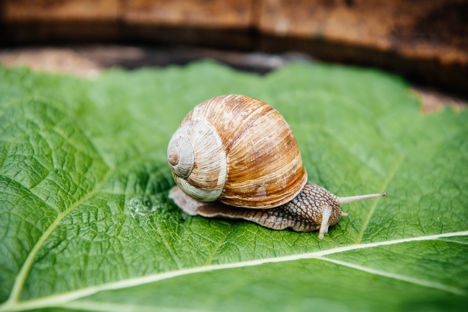
Dorset Snails: putting the gastro in gastropod
Hugh Thomas talks to David Walker about the ins and outs of snail farming, and how the UK's top chefs are starting to use the once maligned product in new, innovative ways.
View more from this series:
ProducersMarcus Wareing, Jason Atherton, Gordon Ramsay – just a few of the chefs who now appreciate the value snails can bring to a menu. And I’m not talking about the French kind, as you might expect, but their British-raised brethren instead.
It’s the first of many surprises in heliculture (snail farming, to you and me), and David Walker – a snail farmer who’s done business with the above household names – is about to reel off a few more revelations. ‘The French only produce around ten percent of the snails they consume,’ he says, ‘and almost every snail France produces goes into tins.’
You see, one of the first things David mentions is the inferiority of tinned snails, and it’s an inferiority that too many people experience, whether they realise it or not. ‘I was talking to a guy this morning. He tried snails, but would never have them again –he thought they were too chewy. That’s typical of a tinned snail. One chef described it as a sort of snail chewing gum, because you swallow once you get fed up with chewing in the end.’
As you might’ve guessed, David’s snails aren’t tinned. His family’s farm, in east Dorset, only rears the fresh stuff. Because of the typical British climate, and because snails love humid conditions (just take a look in your garden on a warm morning after a night of rain), everything’s done indoors.
‘The UK climate isn’t suitable for growing snails outdoors,’ says David. ‘So we’ve put polytunnels inside a chicken shed and we put loads of insulation over the polytunnel, so no daylight gets in at all. For best results, we need twelve hours with lights on, twelve with them off.’
A snail's pace
Understandably, there’s a lot of tweaking and maintaining involved. Even the snails’ waistlines are under tight surveillance, and it’s a bit like Weight Watchers, but in reverse. ‘We grow them from eggs to about ten grams, then we feed them lots of herbs, where they grow up to twelve or fourteen grams. That’s the size we harvest at. Trouble is, they don’t all grow at the same rate.’
The gastropods in question are of the Helix aspersa Müller variety which, as everyone knows (didn’t you?), is second only to the Burgundy snail in having the tastiest meat. The Burgundy, also known as the ‘land lobster’ due to its red-orange tinge, is a protected species however, so don’t even think about eating it. Besides, as David says, it’s far too big for the UK market anyway. ‘A lot of people are virgin snail eaters, so they don’t want a whacking great lump of meat, let alone be expected to cut into it.’
Though these guys aren’t massive, it takes up to twenty weeks for a snail to reach full size, where they’re fed a mixture of high protein soya, pig meal and fine chalk to help develop their shells. Then, for their last few weeks, they’re given an amalgam of dried herbs – parsley, oregano, and the like – before being chilled and, effectively, cured for a few weeks before they’re cooked on a low heat for two and a half hours. ‘They’re deep in hibernation at this point. We never cook a snail that’s crawling around – to us that seems a little on the cruel side.’
Shelling out
Restaurants and pubs receive David’s snails, as mentioned, pre-blanched. But, as well as their meaty texture and flavour, there are other reasons why chefs are drawn to them. ‘Chefs haven’t got to do any work,’ he says. ‘They get them in and stick them in the freezer. When they get an order, they just take six snails, put them under the grill for five minutes and they’re ready to go out. There’s no wastage, because chefs pay per snail, and they love it because they know exactly how much that part of the dish is costing them.’
That’s not to say chefs can’t get carried away – David suggests that, with all the hundreds of photos of dishes he gets from chefs, it always amazes him how inventive they get. ‘Jason Atherton at Berner’s Tavern did them with a pea soup,’ he explains. ‘We’ve started dealing with Gordon Ramsay at the Savoy Grill, and we’ve supplied Petrus for a while. The chef at the time at the Bridge House Hotel in Beaminster did a starter with six snails sautéed in garlic butter on fried bread, with crispy bacon, poached quail’s egg, Dorset down mushroom, tomato and local black pudding. It was one of the nicest snail dishes I’ve tasted.’
To see if David’s snails were as good as the chefs seem to think, I put a dozen of his in-shell snails in the oven. While they may still require five or six chews, they are by no means the shrivelled, flaccid things you tend to find in French restaurants. They actually have body – meaty but delicate – and a flavour, however subtle, detectable even over the garlic and parsley butter.
After that, to call fresh snails and tinned the same product seems like sacrilege. ‘With tinned snails, it’s perfectly good meat when it goes into the tin, but then it’s sealed and cooked at 270°C, which toughens them up,’ says David. ‘Snail meat needs to be cooked on a slow, even basis. The difference is everything.’
David Walker

